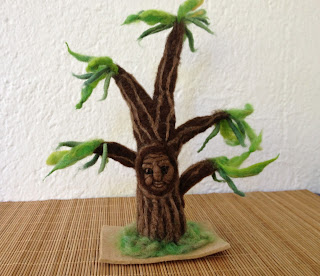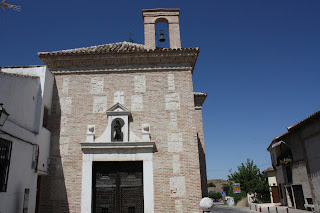There is a nice little folk museum in Chinchón, and it is the main reason for us going there. We knew that there was a textile section. So how do you find this museum on an out-of-the-way side street? If you are in the plaza mayor and facing the church you will make out that there is a pedestrian archway up and to the left.
Hay un pequeño museo etnológico en Chinchón, y es la razón principal por la que fuimos allí. Sabíamos que había una sección textil. Así que, ¿cómo encontrar este museo en una pequeña y apartada calle? Si estás en la Plaza Mayor y encarando la iglesia verás que hay una arcada peatonal arriba y hacia la izquierda.
Here is a close up of the archway. I should probably take this opportunity to mention it is a very small museum, and the information signs are only in Spanish.
Aquí podéis ver un primer plano de la arcada. Probablemente debería aprovechar esta oportunidad para mencionar que es un pequeño museo, y que toda la información está sólo en español.
You go through and will see this sign to your left, then you know that you are on the right track. It is just up this road about 100 meters to your left.
Cuando cruces verás esta señal a la izquierda, entonces sabrás que estás en el camino correcto. Está a unos 100 metros a la izquierda.
Technically I was not allowed to take these pictures. However, I took these without flash and for educational purposes. The main textile section is up on the 2nd (for the US the 3rd) floor. There is a selection of traditional clothing that you can see as you enter the museum, but up here you can see the tools used for making the textiles.
Técnicamente no se me permitió tomar estas fotos. Sin embargo, las tomé sin flash y con propósitos educativos. La sección textil principal está arriba en el segundo piso. Hay una selección de ropa tradicional que se puede ver al entrar en el museo, pero en el segundo piso puedes ver las herramientas que se utilizan para la fabricación de los textiles.
There were hanks of wool hanging from the rafters and the walls. There were really no signs about the wool, other than who donated it, but they remind me of the skeins at the Royal Tapestry Museum in Madrid. The skeins at the Tapestry museum were from Spanish Merino and spun and dyed somewhere in Toledo. Since there were also no signs saying not to touch, I did, and it certainly felt like 100% wool that could have been Spanish merino.
Había madejas de lana colgando de las vigas y las paredes. No había señales sobre la lana, excepto quien la donó, pero me recuerdan a las madejas en la
Real Fabrica de Tapices en Madrid. Los ovillos en el museo de tapices eran de merino Español, hilados y teñidos en Toledo. No había señales diciendo que no tocara, así que lo hice, y ciertamente parecía 100% lana que podría haber sido merino Español.
They look like could have been dyed with natural dyes too.
También parecían haber sido teñidos con tintes naturales.
Here are the two informational signs located to the side of a huge rug loom.
Estos son los dos carteles informativos situados al lado de un enorme telar de alfombras.
My translation of the sign below:
"In the 1950s there were many grand mansions that were converted into workshops for making Spanish knotted rugs. The female pioneers that started this activity and gave jobs to around 200 local women were 14 young women that learned in the a foundation called Fundación Generalísimo.
At full capacity they worked (in this city) on around 50 looms until 1967, at this time this type of work practically disappeared.
Each woman had her own space of 120 rows to knot, which measured about half a meter and they received 8 pesetas (0.048€) for every 100 knots. She was only paid when the rug was finished. The weavers that wanted to receive a reasonable salary would have had to do 12,500 knots each day.
A rug that was 3.5meters long and 2.5 meters wide would have been woven by 5 women and made in 15 days. It would have been sold for 15,000 pesetas (less than 100 Euros).
It was very hard work, because of the tightness of the warp and the continuous use of scissors caused various deformities to the woman's hands; added to this was the fact that the wool gave off a noxious dust that the workers continually breathed in.
Something particular about the "Spanish knot" technique is that you don´t use any type of machine: all of the process is done by hand, every thread is a knot, and knot by knot you weave the rug to completion. The peculiarity that there are neither shuttles nor any other type of mechanism has situated our rugs among the best in the world. If you examine the back of the rug you can see the same design that you see on the front."
Arriba está la traducción en inglés de este cartel; pulsa para ampliar y leer el cartel original en Español.
This next sign reads:
"Antique loom of Chinchón,
for rugs using Spanish knot
(first part of the 20th century)
Recovered by this museum, and actually put to work to make rugs again.
The loom and all of the skeins of wool were donated by Mr. Pedro Del Nero."
So here is the loom. Hand knotted rug means that instead of weaving, each point of color is knotted around the warp and the ends are snipped off with a pair of scissors. So the knots are at the base of the rug and the yarn ends serve as the carpet pile. Every couple of rows of knots there is a line of jute fiber put in between the warp and packed down. The jute fiber adds stability and longevity to the rug. What I know about the "Spanish knot" that remember from my tour of the Royal tapestry museum, is that it is a different and more complicated knot than regular hand knotted rug.
Así que aquí está el telar. Una alfombra de nudos implica que, en lugar de tejer, cada punto de color se anuda alrededor de la urdimbre y los extremos se cortan con unas tijeras. Así que los nudos están en la base de la alfombra y los hilos terminales son como el pelo de la alfombra. Cada par de filas de nudos hay una línea de fibra de yute que se pone entre la urdimbre y se compacta. La fibra de yute añade estabilidad y longevidad a la alfombra. Lo que sé sobre el "nudo español" de lo que me acuerdo de mi recorrido por la
Real Fabrica de Tapices, es que es un nudo diferente y más complicado que otros nudos.
Do you see the drawing behind and in front of the weft? (Click to enlarge.) That is called a cartoon and is kind of a colored graft that allows the rug makers to follow the pattern.
¿Ves el dibujo detrás y delante de la urdimbre? (Haz clic para ampliar.) Eso se llama un cartón y permite a los fabricantes de alfombras seguir el patrón.
A side view of the loom, where you can see that you can raise or lower the loom to get the right tension on the warp.
Una vista lateral del telar, donde puedes ver que se puede subir o bajar el telar para obtener la tensión correcta en la urdimbre.
This is a warping board. The zig-zag pegs at either end make it possible to measure a very long warp in a small space.
Esto se usa para medir el urdido. Las clavijas en los dos lados hacen que sea posible medir un urdido muy largo en un espacio pequeño.
A finished Spanish knotted rug hung up on the wall.
Una alfombra de nudo español acabada y colgada en la pared.
A close up of the rug that was hanging on the loom. Just imagine how plush it would be for tired feet, especially in winter. If this post has made you want your own Spanish knotted rug I believe that the Royal tapestry museum still makes them to order, but I have to warn you they do pay their laborers fair wages and these take hours to make, so it will be an investment.
Un primer plano de la alfombra que colgaba en el telar. Imaginaos la sensación para los pies cansados, especialmente en el invierno. Si este post te ha hecho querer tu propia alfombra de nudo español, creo que en la
Real Fabrica de Tapices todavía los hacen de encargo, pero tengo que advertirte que pagan a sus trabajadores salarios justos y se tardan muchas horas para hacer una alfombra, por lo que será una inversión.


















































